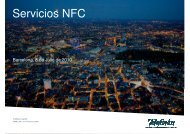Adaptability of cashpoints for the disabled
Adaptability of cashpoints for the disabled
Adaptability of cashpoints for the disabled
- No tags were found...
Create successful ePaper yourself
Turn your PDF publications into a flip-book with our unique Google optimized e-Paper software.
6.6 Glossary <strong>of</strong> sensory disability terminology (providedby ONCE)GLOSSARYVISUAL SHARPNESSThe measurement <strong>of</strong> visual sharpness <strong>for</strong>ms <strong>the</strong> first part <strong>of</strong> ocular examination.Visual sharpness means <strong>the</strong> degree <strong>of</strong> aptitude <strong>the</strong> eye has to perceive spatialdetails, <strong>the</strong>se being measured by <strong>the</strong> angle below which <strong>the</strong>y are seen. Thesmaller this angle, <strong>the</strong> greater is <strong>the</strong> visual sharpness.To measure it, optotypes or panels <strong>of</strong> letters or symbols are generally used.These letters or symbols are arranged in lines, gradually reducing <strong>the</strong>ir sizeand <strong>the</strong>ir design is adjusted to norms <strong>of</strong> size, thickness and separationbetween <strong>the</strong>m. Each line shows <strong>the</strong> distance at which <strong>the</strong> letters or <strong>the</strong>symbols can be clearly identified by a person with “normal” vision.Visual sharpness is determined in each eye separately and with <strong>the</strong> bestcorrection with glasses or contact lenses that <strong>the</strong> person needs. To measureit <strong>the</strong> person sits facing <strong>the</strong> optotype at <strong>the</strong> distance <strong>for</strong> which it is prepared(usually 6 m). If <strong>the</strong>y see all <strong>the</strong> figures, <strong>the</strong>ir visual sharpness will be <strong>the</strong>unit (1), which corresponds to normal vision. If <strong>the</strong>y cannot see all <strong>the</strong> lines,<strong>the</strong>n <strong>the</strong> smallest one that <strong>the</strong>y can see is noted down.The notation <strong>of</strong> visual sharpness may be decimal (0.1- 0.2…) or in <strong>the</strong> <strong>for</strong>m<strong>of</strong> a fraction (<strong>the</strong> numerator indicates <strong>the</strong> distance between <strong>the</strong> personevaluated and <strong>the</strong> optotype, and denominator <strong>the</strong> distance at which <strong>the</strong>normal eye could identify <strong>the</strong> stimulus shown).Visual sharpness must be measured from both far away and close-up.VISUAL FIELDThe area <strong>of</strong> space that <strong>the</strong> eye sees is called <strong>the</strong> visual field. Visual fields areexamined in order to diagnose ophthalmologic pathologies, to study <strong>the</strong>irlocation within <strong>the</strong> visual system and control its evolution.Visual sensitivity is greater in <strong>the</strong> central part <strong>of</strong> <strong>the</strong> visual field, this pointcorresponding to <strong>the</strong> fovea and decreasing as it moves fur<strong>the</strong>r away towards<strong>the</strong> more peripheral areas. There<strong>for</strong>e <strong>the</strong> objects situated in <strong>the</strong> centre orclose to it are clearly seen whereas by going towards <strong>the</strong> periphery <strong>the</strong> size<strong>of</strong> <strong>the</strong> objects must be greater to be seen.72 ADAPTABILITY OF CASHPOINTS FOR THE DISABLED









